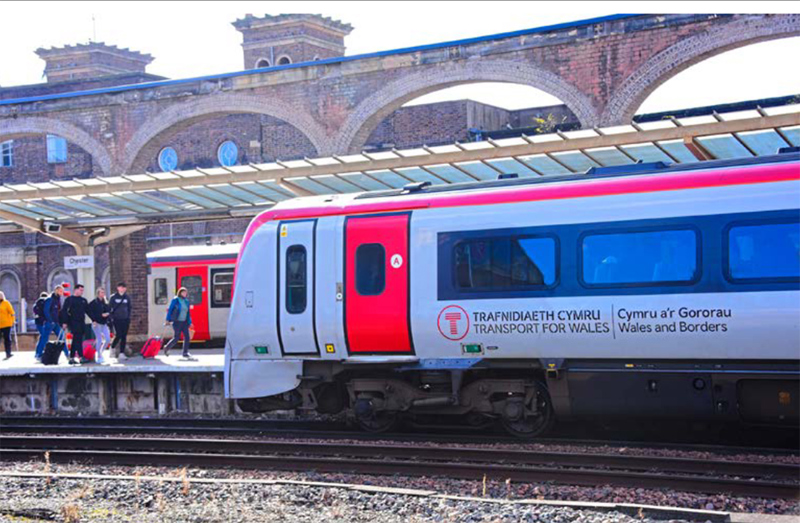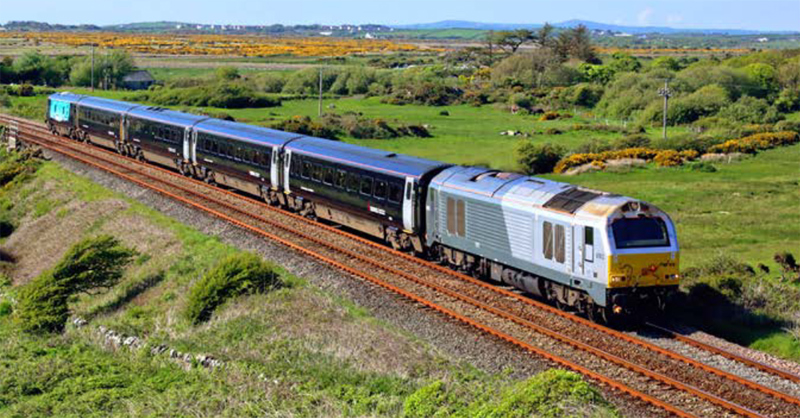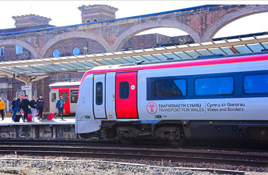The need to develop a fresh business case, and to gain necessary approvals, means that electrification of the North Wales Main Line (NWML - also known as the North Wales Coast Line) is unlikely to start before 2030.
Building a case
Three months after Prime Minister Rishi Sunak announced the £1 billion electrification of the line, nothing has happened - and appears unlikely to in the near future.
Worse, it appears that the scheme is also under-funded, with the £1bn figure based on out-of-date calculations. The Welsh Government’s Economy Minister Vaughan Gething says the £1bn costing was “back of a fag packet stuff” and that “no development work has been done on the project”.
That £1bn figure is based on a now-defunct business case calculated in 2015, since when construction costs have increased by about 7% per annum - meaning that £1.5bn is more likely.
Responding, the UK Government’s Welsh Secretary David T C Davies says the full business case is still to be carried out. He concedes that the £1bn figure is not precise.
“If you want an exact figure, it’s not going to be a billion pounds. I’m not going to pretend that it will be the exact figure - I suspect it will probably be a bit higher than that.”
Explaining the process, he adds: “You start with a strategic outline business case, then you go to an outline business case, and then a full business case, which will give you the cost at the time that’s done. Then usually costs go up a little bit.”
Davies denies that the PM made an announcement with little substance behind it: “It is a cast-iron commitment that we will . It’s not a headline without a plan North Wales still waiting for wiresbecause we have to go through the three-case business stage process, and it takes time to do that.”
'Improvement' grants
An announcement by the Department for Transport on December 7 of a £700,000 grant to the Welsh Government, which it referred to as “£700,000 for Transport for Wales to explore North Wales Main Line improvements”, now turns out to have little to do with electrification. Instead, the grant is for “studying options for upgrading Shotton and Chester stations and increasing capacity on the NWML”.
Announced as part of the outcome of Lord Hendy’s Union Connectivity Review, undertaken during Boris Johnson’s tenure as Prime Minister, this also included a reference to the £1bn electrification scheme.
A re-modelling of Chester station’s track and platforms is proposed, to enable more trains and greater service reliability. This is likely to need to be completed before electrification, and represents the latest challenge for the scheme, which has long- standing and widespread cross-party political support across the region (including Manchester and Liverpool), but which has been ‘on-off’ for over a decade.

Remodelling of Chester is likely to be needed before any electrification project starts. Transport for Wales 175002 waits at the 1848-opened station with the 1041 Holyhead to Llanelli service on October 15 2021. STEVE WIDDOWSON.
One of a number of rail and road schemes that would benefit from the repurposed £36bn projected from cancellation of HS2 Phase 2 (to the north and east of Birmingham), the NWML electrification had been one of the headline schemes announced by the PM on October 4, the same day as his HS2 declaration.
Seeking clarification
Unveiling his Network North transport plan for road and rail, Sunak said: “We will provide an unprecedented £1bn investment to fund the electrification of the NWML, bringing parts of North Wales within an hour of Manchester.
“We will oversee more punctual, reliable journeys on the 126-mile route between Crewe, Warrington, Chester, Llandudno and Holyhead, where ferry services run to Dublin.”
Since then, there has been no further detail, although the 126 miles quoted is the route distance from the existing 25kV at Runcorn, Warrington and Crewe, to Chester and Holyhead, including the 3.3-mile Llandudno branch.

Transport for Wales uses Class 67s and Mk. 4s (coaches that were built to run with Class 91s on the electrified East Coast Main Line) on its Holyhead-Cardiff ‘Premier Services’. These run via the North Wales Coast before heading from Chester to Shrewsbury and then over the Welsh Marches line. On May 12 2023, 67012 has not long started its journey from Holyhead at Rhosneigr. JAMIE SQUIBBS.
Asked by local MP David Jones in Parliament on December 6 when the NWML “will be electrified”, Rail Minister Huw Merriman would only say: “We are in the early stages of planning the next steps for the North Wales electrification scheme and will share further information when that work is complete.
“We are working closely with the rail industry to develop and deliver on the Government priorities outlined in the Prime Minister’s Network North announcement.”
Network Rail tells RAIL that it is not aware of any current activity for the NWML electrification. When Network North was announced, NR CEO Andrew Haines said: “We are now looking forward to working intensively and collaboratively with the DfT and regional partners to develop these schemes.”
Transport for Wales, the Welsh Government’s delivery body, also tells RAIL it has no information on the scheme, although it points out that it submitted an unsuccessful electrification bid in 2016.
Planning expenditure
Approached by RAIL, the DfT was unable to answer any question regarding the £1bn electrification project, merely saying: “Work is already under way on how best to deliver this investment over the coming years.”
The challenge for Network Rail is that the project is not included in its current ‘five-year plan’ - the High Level Output Specification (HLOS) for Control Period 7 (CP7, April 2024 to March 2029).
Before work can start a business case, with full costings and economic benefits, must be approved by the DfT. Work on this could start during CP7, with a view to contracts being let in CP8. After being bruised by the cost over-runs on the Great Western Electrification Programme (GWEP), a more cautious approach is being taken on future schemes.
As a result, a rolling electrification plan proposed in Network Rail’s Traction Decarbonisation Network Strategy (TDNS) in 2020 was scrapped by the DfT in November 2022 as being unaffordable.
Perspective on costs
The cost of electrification is benchmarked per single track km (stkm). The GWEP price, of £3.2m/stkm has been challenged - at the same time in Scotland it was £1.25m to £2m/stkm. In 2019 the Railway Industry Association, representing 350 rail suppliers, concluded that a “well-delivered ‘simpler’ electrification project should cost £750,000 to £1m/stkm; and more complex projects should not normally exceed £1.5m/stkm.”
In 2020, Network Rail’s TDNS used a £1m/stkm to £2.5/stkm figure. The NWML’s 126-mile route translates to 405st/km (including an estimated 30stkm for stations and sidings) coming out at £2.3m/stkm for the £1bn budget.
By comparison a new dual-carriageway road currently costs £38m (A47) to £63m/km (A428).
Are you receiving the RAIL Briefing weekly newsletter? Join us to receive news, opinion and market insight on Britain's railways.















Login to comment
Comments
Hugo - 16/01/2024 09:36
any chance of the GW being finished first? Bristol Temple meads to Parkway, and to bath and chippenham, oh and oxford to didcot? perhaps to birmingham?
Peter Black - 17/01/2024 08:17
The reason for no progress, is that every time anyone has looked at it seriously, there is no business case for NW coast electrification, let alone a financial case. It is a pure political project to divert attention from cancelling Hs2 and will be quietly dropped. In any case, the rail industry is currently unable to deliver affordable electrification. Recent schemes have been close to the disastrous GW levels, and TPRU may even exceed it. The industry needs to get its own house in order.
(Dr) Pedr Jarvis - 17/01/2024 15:15
One of the tributary lines in North Wales still has carriages in carmine-and-cream or even L&Y purple-brown. Things don't change much in those parts.